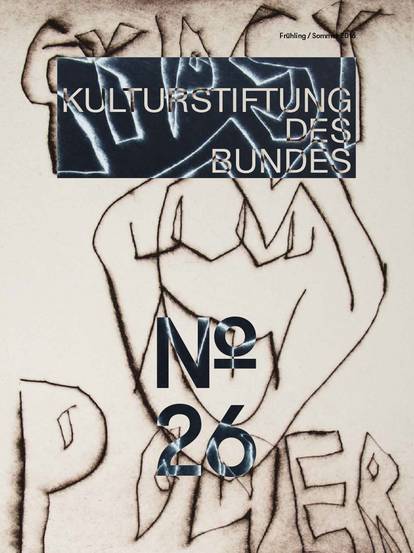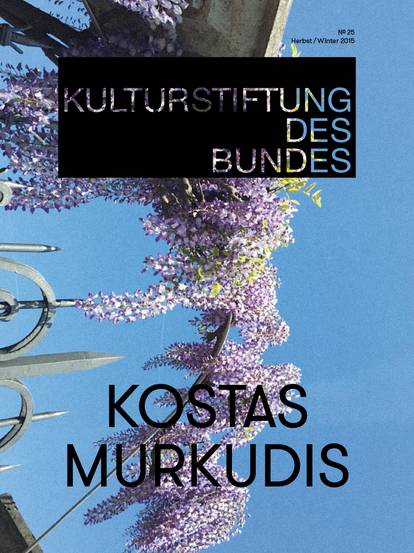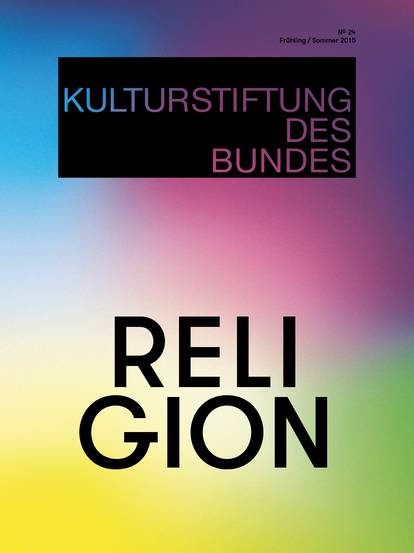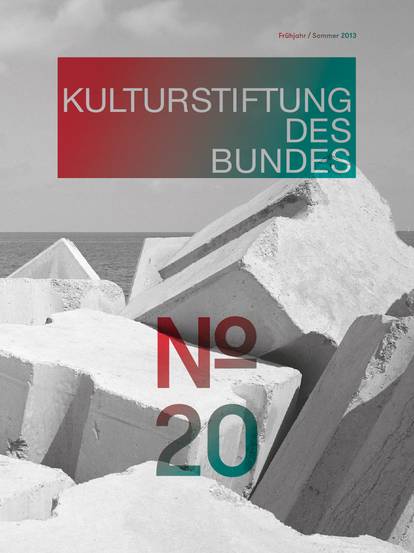"The entire work, named art, knows no boundaries and peoples, just humanity." The Lenbachhaus in Munich has adopted Wassily Kandinsky’s credo as the starting point for re-examining its extraordinary collection of Blue Rider works in the global context of other artists’ collectives. Not only will the curatorial team have to rethink its exhibition strategy, but also change its perspective, which had long been limited to works of modernity. Matthias Mühling, the director of the Städtische Galerie im Lenbachhaus, elucidates on the considerations and plans underway at his museum.
Hardly any artists’ collective is as internationally renowned as the Blue Rider. Why is this, would you say? Might it be that certain views have condensed into a cliché which is propagated in museums and explains the influx of visitors?
It is quite astounding that artworks from what is now the period of ‘classical’ modernism have become so popular. Indeed, we should ask ourselves why this is so, why a society emphatically embraces art which is almost one hundred years old and which struggled to gain the approval of contemporary audiences, and occasionally didn’t even want to. This popularity naturally benefits a movement like the Blue Rider, and by extension, a museum like the Lenbachhaus which holds the world’s largest collection of works by this circle of artists. Paintings by Gabriele Münter, Wassily Kandinsky, Franz Marc and August Macke are generally regarded as “beautiful”. And there is, in fact, something beautiful about the idea of modernism. It holds the promise of world improvement, of utopias, enlightenment and progress, and art instils these ideas with a specifically novel style: colourful, expressive, reduced to the essentials. Expressionism is certainly something that can devolve into a cliché.
What has been lost in our conventional perception of expressionism?
We easily forget the potential for disruption which this art form used to have, its capacity for scandal. Oskar Maria Graf reported on the lack of comprehension, even anger which Munich’s citizens expressed when presented with blue horses and abstract depictions of mountains. And Kandinsky wrote in his memoirs that viewers would sometimes spit on the exhibited works. It is difficult, if not impossible, to present these impressions and the reasons for them to audiences today. What’s more, when contemplating the promise of modernity as expressed in art, most people are too willing to forget the less positive side effects of the modernisation movements which continue to impact the entire world today.
For decades, museums focused largely on painting and the smallest circle of the female, and in particular, male artists of the Blue Rider. The 1912 almanac entitled Der Blaue Reiter has been the focus of increasing attention for some time now. Kandinsky and Marc produced this publication, which will serve as the thematic thread for our project. There is a universal understanding of art expressed in the almanac, the idea of a cross-genre, non-hierarchical and global art. One of its tenets: “The entire work, named art, knows no boundaries and peoples, just humanity.” This is demonstrated in exemplary manner in the section of illustrations: There are no hierarchies in the arrangement of the participating artists or works of European and Russian folk art, children’s drawings, and a great many works from different epochs from China, India, Mexico, Guatemala, Brazil, New Caledonia, Egypt, Cameroon, Malaysia and the Marquesas. This view of art as providing a common language of “humanity” independent of cultural education and national affiliation was quite visionary during that period of colonial world order before World War I. Of course, from today’s perspective, we should also critically evaluate the basic premises and achievements of the almanac. The reference to “humanity” glosses over historical-cultural relationships and imbalances of power in favour of a presumed global “essence”.
Your exhibition draws attention to the subject of artists’ collectives which is a central aspect of the Federal Cultural Foundation’s “Global Museum” programme. What does this group possess that any individual member – many of whom were famous – doesn’t have?
The same as in all endeavours which are the result of collective cooperation: The group is stronger than any single person. Unions, protest movements and artists’ collectives are quite similar in this respect. Community possesses great value – being there for one another, challenging each other, working together. Relationship work is absolutely vital for the stability of society.
Another thing artist groups of modernity have in common is their rejection of the genius cult surrounding single artists, who are supposedly so vastly different and much better and sublime than all others. Some of them also renounce the academy-market-museum system and its money-driven business and rewards.
In the context of the “Global Museum” project, we at the Lenbachhaus see the artists’ collective as a necessary and long-overdue effort to examine the categories of authorship, autonomy, ideology, and canonical aesthetics. Especially because the Blue Rider itself also questioned these categories. And not least of all, the focus on artists’ collectives is an opportunity for us at the museum to think and work in an even more collaborative way.
How do you explain that only a handful of the founding members and participants in the activities by the Blue Rider are still known today? Others, outside of professional circles, are all but forgotten.
The reception of the artists of the Blue Rider was characterised by an increased interest in individual positions. Naturally, this is due to the fact that practically all of the members had long careers which continued beyond the brief existence of the Blue Rider, and the reasons for their fame lie in their complete oeuvre. The Blue Rider also invited unaffiliated artists to participate in their exhibitions, some of whom were already quite well-known outside the group, such as Robert Delaunay or Hans Arp. What’s interesting is that compared with Marc, Kandinsky, Macke, Alexej Jawlensky, Paul Klee or Alfred Kubin, the female artists like Münter and Marianne Werefkin were treated rather shabbily and were strongly defined through their partners. For this we can justifiably lay blame on museums, curators and also the book market, for instance. The desire for large audiences and higher sales figures by rehashing the same famous names over and over can hardly be undone.
Is the image we have of the Blue Rider group too homogenous? Were there any inner conflicts which we prefer to ignore so as not to tarnish the “pretty group picture (with ladies)”?
The image of the Blue Rider as a homogenous, harmonious artist group is certainly a cliché. Perhaps it was most accurate in 1908/09 in Murnau where Kandinsky, Münter, Jawlensky and Werefkin spent a number of productive weeks painting together, sharing ideas and going through a similar, innovative stylistic development. There is legitimate reason why this period has been attributed to the Blue Rider, though it actually took place shortly before the group existed. Indeed, the four artists had just formed the Neue Künstlervereinigung München (New Artist Association of Munich, or NKVM) with several other colleagues in 1909. To be exact, the history of the Blue Rider began with the first conflict. When the majority of the NKVM jury refused to include Kandinsky’s large-scale, almost wholly abstract Komposition V in its third exhibition, Kandinsky, along with Marc and Münter, resigned from the association. The history of the Blue Rider is essentially comprised of just a few activities. They organised the now famous First Exhibition by the Editors of the Blue Rider – named after their almanac which was already in planning – at the turn of 1911/12 at the Galerie Thannhauser, and included works by several new artists, such as Albert Bloch, Delaunay, Macke and Schönberg. In spring 1912, they presented their second exhibition featuring solely graphic art, followed shortly thereafter by the publication of the almanac. The brief history of the artists’ circle concludes with various exhibition activities, including the tour of the first Blue Rider exhibition, which was shown until 1914 and made it all the way to Scandinavia.
Plenty of conflicts flared among members of the group in these short years. They were both artistic and personal in nature, they occurred between subgroups, between couples, between the sexes, between the more affluent and poorer members, and were also sparked by the relationship to gallery owners and publishers. The First World War put an end to all of the lively and intensive discussions. The letters exchanged between these artist friends, right up to their untimely deaths in some cases, are an elegy to the time they shared together.
The prevalent idea of the Blue Rider as a compact, even mythical artist group, however, is a phenomenon of its post-war reception after 1945, first in Germany, and then internationally in the Western world.
What distinguishes the Blue Rider from other artists’ collectives which are still widely discussed today – the Bauhaus, the Dadaists, the Surrealists, Black Mountain College and the like? Did they have anything in common or any striking differences?
The Blue Rider wasn’t and never wanted to be an art institution. The Bauhaus, for instance, had an institutional structure – founded by Walter Gropius in Weimar in 1919 on the basis of the State School of Arts and Crafts in Weimar with a focus on architecture, and then later in Dessau, on industrial design – or Black Mountain College in North Carolina, in which Josef and Anni Albers continued cultivating the Bauhaus philosophy after their emigration to the United States. The Blue Rider wasn’t even a tight-knit artists’ collective like the Parisian Surrealists or the artists of Die Brücke, who were also collaborating on their joint programme around the same time (1905/1913) and shared a high degree of stylistic similarity. The Blue Rider was rather a loosely connected circle of artists which shared a basis of diversity. This pluralism of expressive forms – for example, the expressive abstraction of Kandinsky, the predominant animal symbolism of Marc, the colourfully vivid reinterpretation of reality, landscapes, still-lifes, portraits, the Zoological Garden and walkers by artists such as Münter, Macke and Elisabeth Epstein, or the intellectual artistic images produced by Klee – these essentially distinguish the Blue Rider from other artist groups of that time.
What united them was rather a spiritual approach, namely finding new forms in art capable of immediately and authentically expressing its content – the inner vision. This spiritual idea of the Blue Rider, particularly evident in Kandinsky’s and Marc’s belief in the “spirituality of art” which led them towards abstraction, did in fact have artistic repercussions with numerous references throughout the 20th century until the present day. For example, just think of abstract expressionism in the post-war era in America and France, or the numerous references to symbolism in artworks by Klee.
How “globally” active was the group? Was it able to put its transnational credo into practice?
The Blue Rider was “globally” active in the sense that it collaborated – to an astonishingly great extent – with other European and Russian colleagues – and with the American synchronists through Marsden Hartley. They were – and this is important to point out – the only avant-garde movement that succeeded in conducting joint European activities. They reached out to international artists, especially from Russia, France, Switzerland and Austria, for contributions to their almanac Der Blaue Reiter. Moreover, Macke and Marc succeeded in commissioning an array of well-known international avant-gardists for the large Sonderbund exhibition in Cologne in 1912 and the Erster Deutscher Herbstsalon (First German Autumn Salon) at Herward Walden’s Sturm Galerie in Berlin. In this respect, both projects were among the most significant international art exhibitions prior to the First World War, and nothing comparable took place in any other country.
In the non-hierarchical view of art, as expressed in the almanac, which assumes a basic equality of human emotions and expressive forms, there are also underlying social and democratic ideas. How “social” were the members of the Blue Rider, how “democratically-minded” were they really?
The “social question” was a topic which Kandinsky had discussed with interest in his unfinished law dissertation. It would be worth investigating to what extent the Blue Rider was truly moved by the real-life experiences of normal people. Specific references in the almanac to “social” and “democratic” ideas can be found in several annotations in the Russian contribution by the Burliuk brothers.
In the end, the references to these topics are only implicit. Kandinsky and Marc, as well as the other editors of the almanac Der Blaue Reiter, among them Arnold Schönberg and Macke, were far more focused on renewing life through art and combining new artistic forces in Germany and abroad in order to achieve spiritual sublimity. The practical implementation of these ideas, for example, through the selection of images for the almanac, presenting artworks side by side by different peoples and from different times in equal standing, had a significant impact. The modernist moment of the Blue Rider lies in this pluralism of forms and the assertion of multi-layered dimensions of meaning – aspects which continue to enjoy relevance and acceptance to this day. For they expected nothing less from this aesthetic renewal than a common “language” which could be used to communicate beyond the restrictive boundaries of national languages and cultural education from which we come.
Yet the artistic language of the Blue Rider has become much more the group’s “brand” than their philosophy of spiritual and social change. Why aren’t we reminded of this more often, or rather, why hasn’t it left more of an impression on our cultural memory?
Actually we do believe that the writings in the almanac or Concerning the Spiritual in Art by Kandinsky have had an enormous and widespread impact. When I was teaching in Colombo, the painting professor there was translating Concerning the Spiritual in Art into Singhalese. All of the students wanted to discuss this text. There are more than mere traces of this philosophy which still exist in our cultural memory. The fact alone that primary-school children in almost every school in Germany receive instruction in painting, or that a standard of German schooling is teaching children abstract design while they listen to music, demonstrates how strongly our thinking has been influenced by the Blue Rider. It’s only that we don’t always know where these ideas originally came from. With regard to artistic production, the Blue Rider was interested in spirituality and in direct and unadulterated feeling, not in technical mastery. It regarded the creative expression of children as an ideal. In this sense, we can describe their paintings as democratic in the best sense of the word, for these are not brilliant masterpieces created by extraordinarily talented individuals, capable of producing something after years of academic training and maturation of their craft, which they alone master.
One of the direct consequences of the Blue Rider is that we can go into a museum, free of the burden of historical knowledge, and judge its relevance to our lives, or simply enjoy it. The arrangement of the images in the almanac doesn’t convey art-historical facts, but rather suggests that every work of art belongs to the present and can be interpreted even if detached from its historical circumstances.
One of the most magnificent ideas in the almanac Der Blaue Reiter is that every cultural achievement is valuable. The history of the destruction of cultural works shows us, unfortunately, that this idea is by no means self-evident.
What hypothesis do you work with when you present other artists’ collectives from different parts of the world in the context of, or as a co-text to, the Blue Rider?
We don’t have a hypothesis; we ask ourselves lots of questions because we want to get past our blind spots which exist in our knowledge and even in our areas of academic interest.
Instead of proposing a hypothesis, we confront similar processes at different locations and create a narrative from it. Once upon a time, 1901, the same year Kandinsky along with several artists in Munich established the artists’ association and art school “Phalanx”, the resistance forces of the Asante Nation in present-day Ghana – after several years of armed conflict and despite military defeat – succeeded in securing a cultural victory. They deceived the British by defending a replica of the “Golden Stool”, then relinquished it and allowed it to fall into the hands of the British. While the colonial rulers triumphantly transported a fake throne back to London and exhibited it as proof of their superiority, the original remained in the possession of the Asante. As a result of their successful deception of the British, the Asante and their neighbours cultivated a collective and subtle form of symbolic communication, which is now prevalent in many parts of Africa today and can be described as an aesthetic form of resistance: Wax-print textiles, which had first appeared several decades earlier in West Africa, became an ideal medium of communication. Fabrics bearing images of throne stools or parasols, symbols of the political system of the Asante, rapidly became widespread and were employed as a kind of “silent” protest, to which the colonial administration was oblivious. This is how a group of people were able to raise their voices without speaking – a strategy which quickly spread across the entire West African region and the continent and is closely linked to the idea of human dignity (especially) in the face of political oppression. The goods produced using the wax-printing technique developed in the Netherlands eventually became an African material, a hybrid cultural technique. From the point of view of the suppressed, such aesthetic means of expression and appropriation served as examples of how colonial rule could be infiltrated in a subtle way. The Phalanx is firmly anchored as a key component in the successful narrative of modernism. Compared with the local scope of the Phalanx’s art-based projects, the action by the Asante had global consequences. The Asante also used aesthetic and artistic methods for politically asserting their own identity and their aversion to colonial rule. Both strategies are highly relevant today, also for the international exhibition community, as well as for joint political and aesthetic action in a broader sense. Direct comparison allows us to highlight strategies or readjust assessments. We want to learn more about such relationships, also parallel developments, and consider them as part of the larger picture.
Could you describe the goals of your exhibition in terms of “before and after”?
We feel the need to reacquaint ourselves with the Blue Rider thanks to a more global perspective, and we hope that this has lasting effects on our future work with the collection. We feel it’s important to critically re-evaluate the collection holdings. The museum staff of the Lenbachhaus hope that this project will result in a revision and expansion of their curatorial and art-historical views. The question regarding the specific character of an artists’ group (not the individual artists), the question of inspiration and impact, also with respect to the international context, requires a new approach and a new investigative method. This includes, for example, combining the findings from all other relevant disciplines like ethnology, history, folklore or postcolonial studies. Various art forms were and continue to be assessed in different contexts – and this should be pointed out in the exhibition. Yet, we have to rethink the forms of presentation and develop them further in order to illustrate the cultural relationships through graphic narration, for instance, instead of auratic depiction. Hopefully this will enable us to draw attention to objects and documents from the diverse estates of the Blue Rider artists which we have overlooked in the past because they didn’t correspond to the conventional categories of “art”.
The questions were asked by Friederike Tappe-Hornbostel.

![[Translate to English:] Magazine 38](/fileadmin/_processed_/f/1/csm_Magazin38_Cover-Vorschau_921x1230_689f428dc3.jpg)
![[Translate to English:] Magazine 37](/fileadmin/_processed_/b/c/csm_Mag37_Cover-Vorschau_921x1230_b5129fdb2a.jpg)
![[Translate to English:] Magazine 36](/fileadmin/_processed_/2/a/csm_Cover_Magazin36__issuu_2f3cef97bb.jpg)





![[Translate to English:] Magazine 30](/fileadmin/_processed_/c/b/csm_magazin30_vorschau_9005f773d3.jpg)














